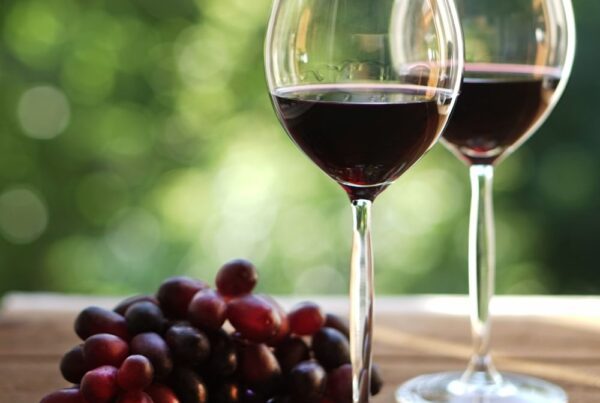In this article, you will learn where Malbec originated and where it is made today.
Malbec is a red wine made from a grape of the same name. You may have heard conflicting views about where it is from.
Quick answer: Malbec is originally a French grape and it is still widely grown in the Cahors region of France; however, these days Malbec is synonymous with Argentina, where the majority of Malbec is produced.

Contents
What is Malbec wine?
Malbec is a black grape variety that is originally from France, but today it is grown around the world.
The majority of Malbec is grown in Argentina, but it is also grown in Chile and in small amounts in countries like Italy, Australia, USA, South Africa and Canada.

What Malbec tastes like
Malbec is a deeply colored, full-bodied red wine with black fruit flavors (blackberry, blueberry, black cherry) and a velvety, smoky finish.
It can also have coffee, chocolate, black pepper and vanilla aromas and flavors, depending on how it is made and aged.
Argentinian Malbec
According to Wines of Argentina, Miguel Amado Pouget, is credited with first bringing the Malbec grape to Argentina. He was a political exile who left France after Napoleon III’s coup in 1851.
Argentina has the largest plantings of Malbec in the world (around 70%). It is where the Malbec grape is most at home and finds its best expression.
The growing conditions and climate are some of the reasons why the Malbec grape grows well in Argentina. The Malbec grape is a fussy grape that requires the right growing conditions. It is susceptible to frost, rot and pests.
Argentine vineyards are often planted at high altitudes – the average elevation being approx. 3000 feet or 900 meters above sea level. The dry mountain air reduces risk of disease, and the use of pesticides.
The naturally low-disease growing environment means that Argentina is leading the way in the production of organic wines. Mendoza is one of the world’s leading organic regions, with organic winemakers like Bodega Argento.
The high altitudes also provide hot days with low temperatures at night. This variation in temperature provides the environment Malbec needs to develop acidity. Acidity is important in wines for flavor and is a necessary component for age-worthy wines.
The low overnight temperatures are also necessary to grow wine so close to the Equator.
Best Argentinian Malbec
Argentina produces some of the best Malbec in the world. The vast majority of Argentinian wine is produced in Mendoza (76%), and Central Mendoza has a long history of producing some of their best quality wine. Some of the best and most famous winemakers are based there, such as Bodegas Bianchi.
Luján de Cuyo
Lujan de Cuyo, which lies south of Mendoza city has a reputation for producing high-quality Malbec. It is known for its old vines that produce quality, concentrated wines.
It was the first Denomination of Controlled Origin (DOC) on the continent and it was introduced in the early 1990s by producers looking to protect and define their regional style, which features the use of old vines (generally considered to produce better quality wine).
Lujan de Cuyo DOC controls include:
- Vines must be at least 10 years old.
- Wine must be aged for at least a year in barrels and for two years before it is released on the market.

French Malbec
In the past, Malbec was grown widely in France, but it is not widely grown there anymore.
Today, Malbec is grown in Cahors, Bordeaux and the Loire valley.
Malbec is a permitted Bordeaux blend but it has not been widely grown there since the majority of the crop was wiped out by frost in the 1950s.
French Malbec is usually grown to be blended with other grapes.
Cahors in South Western France is where the majority of Malbec is grown in France. The traditional name for Malbec in Cahors is Cot or Auxerrois.
Local wine regulations (Appellation d’Origine Controlee AOC) require at least 70% of wines are Malbec with the remained being Merlot or Tannat.
Wines from Cahors were traditionally known as ‘black’ wines because of their deep color and high level of tannins. Young Cahors have aromas of black fruit that can evolve into ripe plum and prunes.
The best Cahors Malbec is deeply colored with intense black fruit, high tannins and are aged in oak.
French Malbec is sometimes described as gamey or rustic where Argentinian Malbec is often described as spicy and velvety.

Malbec vs other red wines
If you are wondering how Malbec compares with other wines, I have created a table below comparing Malbec with three international varieties: Merlot, Shiraz/Syrah and Cabernet Sauvignon.
The table compares Malbec, Merlot, Shiraz/Syrah and Cabernet Sauvignon in terms of flavor, tannins, body, alcohol levels etc.
Please note that each of the wines listed below can taste different depending on lots of different factors, such as climate, winemaking techniques, ageing, quality of the grapes etc.
So, the table below is a general guide.
As you can see, they have a lot in common.
| Name | Flavors/Aromas | Color | Tannins | Sweetness Levels | Alcohol Level | Body | Acidity |
| Malbec | Black fruit (blackberry, black plum, blueberry) red currant, liquorice, smoky, clove, pepper (Argentina) | Deep | Medium- high | Dry | Medium-high | Full-bodied | Medium |
| Merlot | Blackberry, black plum, black cherry, liquorice, truffle, coffee | Deep | Medium-low | Dry | Medium-high | Medium-full-bodied | Med or low |
| Shiraz/Syrah | Blackberry, blackcurrant, bilberry, red currant, liquorice, chocolate, pepper, smoky | Deep | Medium-high | Dry | Medium-high | Full-bodied | Medium |
| Cabernet Sauvignon | Blackcurrant, black cherry, bilberry, raspberry, bell pepper, liquorice, clove, smoky | Deep | Medium-high | Dry | Medium-high | Full-bodied | Medium |
What temperature to serve Malbec wine
Serve Malbec wine at room temperature 15-18 °C (59-64°F).
For more information, see our article on serving red wine at the correct temperature.
World Malbec Day
April 17th is World Malbec Day. First celebrated in 2011, this date was chosen because on April 17, 1853 Pedro Pascual Segura presented a project to the Provincial Legislature to establish the Quinta Normal and Agricultural School. This project was approved by the House of Representatives later that same year.
It symbolizes the transformation of the wine industry in Argentina and the beginning of the development and success of its most famous grape Malbec.
FAQs
Is malbec wine dry or sweet?
Malbec wine is dry.
How do you pronounce Malbec?
Malbec is pronounced: mal-beck
Is malbec a cheap wine?
The price of Malbec, like most wines, varies. I wouldn’t describe it as a cheap wine. You can buy cheap Malbec, but it can also be a great value wine.
Great Malbecs can be purchased at good prices. You can find a decent Malbec for under $20 and a great one for under $50.
Read with confidence: I am a certified wine expert (WSET L3).




